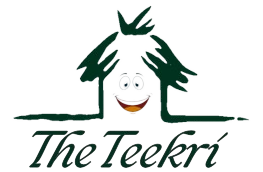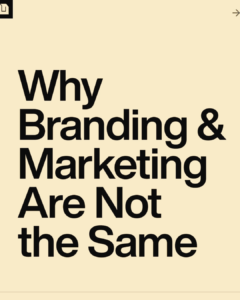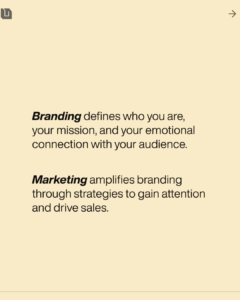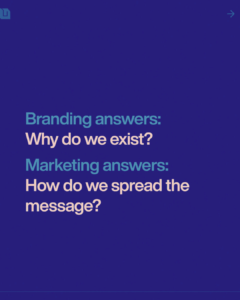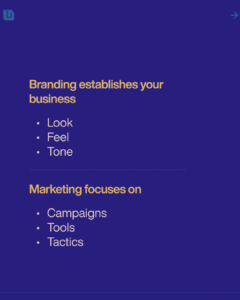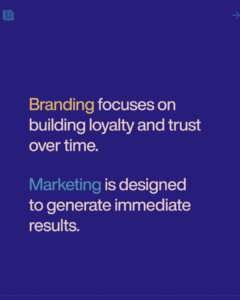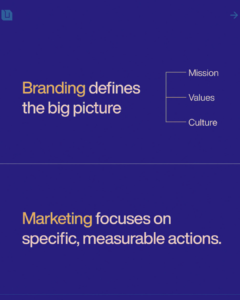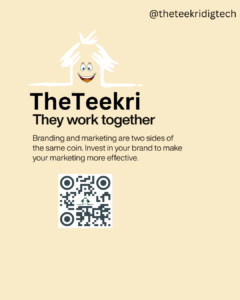
Why Branding and Marketing Are Not the Same
Branding and marketing are often used interchangeably, but they are distinct concepts that serve different purposes in the business world. Understanding the difference between the two can help businesses craft more effective strategies for long-term success. Let’s explore these differences and their unique roles in a business strategy.
What Is Branding?
Branding
is the process of creating a unique identity for a company or product. It
encompasses the values, personality, and vision of the business. Branding
answers questions like:
Who are we?
The question “Who are we?” in the context of branding refers to the foundational inquiry into a company or organization’s identity. It involves defining the core essence of the business, including its values, mission, and personality. This question seeks to encapsulate the brand’s purpose and how it wants to be perceived in the minds of its audience.
For example, a company that produces eco-friendly products might answer this question by emphasizing their commitment to sustainability, innovation, and community impact. It sets the stage for creating a brand image that resonates with the target audience on an emotional and ethical level.
Would you like further elaboration or an example specific to an industry?
What do we stand for?
The question “What do we stand for?” addresses the fundamental values and principles that guide a company or organization. It defines the ethical, moral, and philosophical stance the business adopts and communicates to its stakeholders. This question helps a brand identify and convey its purpose beyond just offering products or services.
For example, a company might stand for sustainability, innovation, or social responsibility. This identity can be woven into everything the company does, from its operations to its marketing strategies, creating a consistent and authentic connection with its audience.
Would you like more examples or insights on how businesses answer this question effectively?
What makes us unique?
The point “What makes us unique?” refers to identifying the specific characteristics or qualities that distinguish a company, product, or service from its competitors. This involves defining the unique value proposition (UVP), which could include aspects like innovative features, superior quality, exceptional customer service, or a distinct brand personality.
For example, a coffee company might highlight its use of sustainably sourced beans and eco-friendly packaging as what makes it unique. This uniqueness not only sets the company apart in a crowded market but also helps build a stronger emotional connection with its target audience.
Would you like to explore specific strategies for identifying or leveraging uniqueness in branding?
Key elements of branding include:
- Logo and Visual Identity: The design elements like logos, color schemes, and typography.
- Mission and Vision Statements: The core principles that define the company.
- Brand Voice: The tone and style of communication.
- Customer Perception: The emotional connection people have with the brand.
What Is Marketing?
Marketing is the set of activities and strategies used to promote products or services to the target audience. It focuses on driving engagement and conversions by:
- Identifying customer needs.
- Creating promotional campaigns.
- Distributing content across various channels.
- Measuring campaign effectiveness.
Key elements of marketing include:
- Advertising: Paid campaigns across platforms like Google, social media, and TV.
- Content Creation: Blog posts, videos, and infographics designed to inform or entertain.
- SEO and Analytics: Tools to improve visibility and measure performance.
- Customer Engagement: Interactions on social media, email, and customer service channels.
The Key Differences between Branding and Marketing
Aspect
Definition
Focus
Purpose
Elements
Timeline
Branding
Creating a unique identity and image.
Long-term emotional connection.
Defines who the business is.
Logo, mission, values, customer perception.
Continuous and evolving.
Marketing
Promoting products/services to customers.
Short-term goals like sales and leads.
Communicates what the business offers.
Campaigns, content, channels, analytics.
Time-bound and campaign-specific.
How Branding and Marketing Work Together
While branding and marketing are different, they are interdependent:
- Branding sets the foundation for marketing: A strong brand identity provides consistency and credibility for marketing efforts.
- Marketing amplifies the brand: Effective campaigns bring the brand’s message to a wider audience.
For example, Apple’s branding emphasizes innovation and simplicity, which informs all its marketing efforts. Whether it’s a product launch or an advertisement, the marketing reflects Apple’s core identity.
Conclusion
Branding and marketing are two sides of the same coin. Branding defines who you are, while marketing communicates that identity to your audience. Businesses that understand and integrate both will build stronger customer relationships, increase loyalty, and achieve long-term success.
Author
